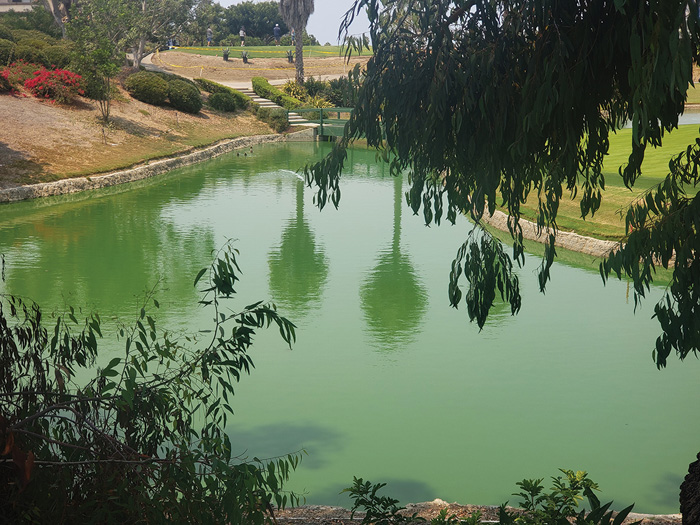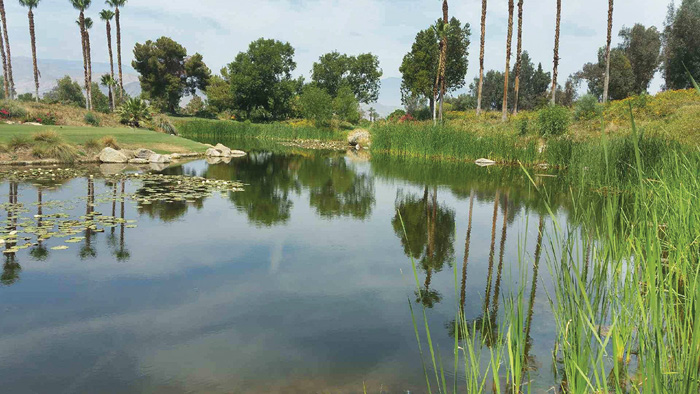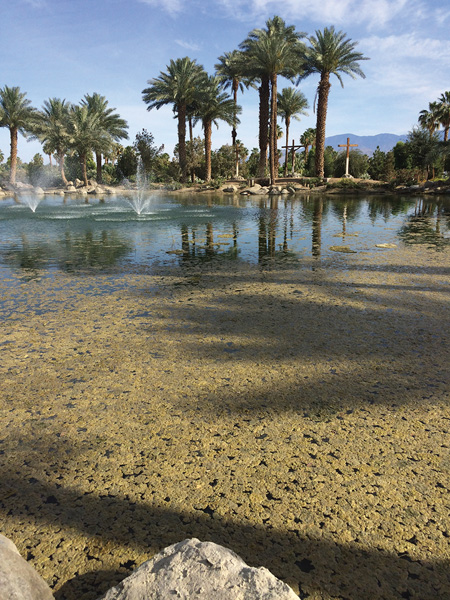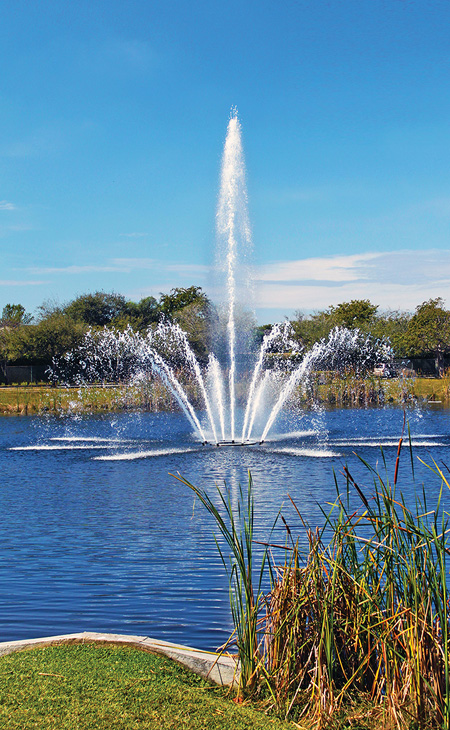
Almost every day I am asked to outline a water treatment plan. New clients and old friends alike expect the answer to be simple, but there are many “it depends” caveats. Each body of water is unique and responds best to a slightly different approach. Even if the dosage is simple, the application is as important as the products used. These conversations often reveal that the owner is unsure of site-specific details, the deeper challenges presented and the nuances of water treatment. Setting all that aside, the following is a simplified approach to aquatic treatments.
The best management practice for water is to use the least amount of chemical treatment. This is balanced against the need to control unwanted and invasive species, all while minimizing labor. Ecologic diversity is the long-term goal. Below a certain dosage, chemicals have a negligible effect. Therefore, an aquatic program generally first increases toxicity, then ramps down chemical usage. Ultimately, the aquatic plant growth becomes acceptable, costs are reduced and the water ambience and function are maximized.
Water Quality Factors
First, consider the water volume and source. What is the surface area and average depth? Does it fill with water from an aquifer, a deep well, city water or reclaimed water? The less pristine the source, the higher the nutrient loading, and thus the more product needed for the same level of control. This also applies to landscaping and nearby animals, especially uphill and upwind.
Make sure the water has enough dissolved oxygen (DO) available, both for the fish and other oxygen-consuming creatures. Generally, 4 ppm is poor DO, and above 6 ppm is good. At 3 ppm or below, you will see fish kills. Higher DO will discourage the growth of algae and cyanobacteria, as these excrete oxygen. Lower-temperature waters can hold more DO, and more salinity can reduce DO. Thus, more wind increases DO and evaporation. A lake often requires mechanical aeration to have sufficient DO, such as diffusers, fountains and waterfalls.Water depth is important to know not only for application calculations, but also for biologic function estimations. Comparing the current depth profile with the original design, the difference is the accumulation of muck, which is a combination of dirt, clay and biologic material. Bottom diffusers are less effective at DO introduction at depths less than 6 feet; depths greater than 40 feet see less DO despite the lower temperatures at those depths.
Always remember: Moving water is healthy water. How long does it take for the entire volume to recycle? Healthy water turns over a few times a day. Circulation implies mixing, which is enhanced by bottom diffusers at all depths. Large bodies of water often have coves and fingers, which have lower circulation. The larger a lake, the less likely it has good circulation, especially at the deepest points.

Environmental Factors
Where does the water flow when it leaves your property? U.S. EPA and state laws limit pesticides and other products in water. A property owner should not add any product before understanding the laws governing their property and the property downhill receiving effluent.
Peripheral trees and other high-nutrient sources may need to be moved or eliminated. Increased light will result in more algae growth. Increased wind from tree removal will help the DO but will also increase evaporation. More evaporation will increase the cost of water replacement, so dissolved solids in the water may increase.

Some lakes are devoid of aquatic grass. The introduction of fast-growing aquatic grass can address this problem. In later years, this grass could take over between 50 to 80% of the lake’s surface, requiring a huge annual expense to cut back. Before adding or subtracting to a waterscape, including the nearby landscaping, consider the long-term outcomes carefully.
Goals & Limitations
Clearly define your highest priority and identify those who may disagree with your goal or wish to amend the process. Water management is not intuitive and often has capital and recurring costs. Many companies offer different products and processes that promise similar outcomes. Some prefer killing everything for maximum control in the short term, minimizing labor and short-term cost. Others prefer the ecological approach — using subtler products that turn the big ship around, so to speak.
A reservoir owner wants maximum volume with toxicity just below the legal limit. A mixed-use homeowner’s association wants fish and no algae blooms, with butterflies and birds coming back each year. Depending on the property, either can be correct.
In any case, the first step is usually taking control of algae and cyanobacteria, which may be at the advanced stage in a harmful algae bloom. Copper products are the most effective and come in several forms. Using a double-chelated product, which is a liquid, is the most efficient. Commonly we use an algaecide, which introduces 0.1 ppm copper for each gallon applied to 1 acre-foot of water, persisting for about 21 days. Control generally begins at 0.2 ppm; 1.0 ppm copper is the EPA limit for potable water. Using these concepts, we can make a plan to address the owner’s goal.
Example Calculation
For example, consider a volume of water 300 by 700 feet with an 11-foot average depth, which comes out to 2,310,000 cubic feet. The lake is a closed system with average water source quality and no effluent issues. The surface is 4.82 acres, or 210,000 sq. ft. — so a fairly large lake surrounded by trees and brush. The circulation is poor, with high westerly winds and an average daily air temperature of 85 degrees Fahrenheit.

The lake was built in 1975 as a reservoir for cattle and crops, plus flooding protection. With an original depth of 25 feet, its bottom layer is 60% mud, 40% bio-muck, reducing the original volume by about half. The abundance of minerals makes this “hard water,” which is known to precipitate copper in lower-quality algaecides. The water is very turbid with a planktonic alga, plus a top matting of Lyngbya. There is no aeration. A new owner has finished building a home on the lake, and their large family enjoys fishing and being outdoors with their dogs.
So, what do we do?
The family wants a fast fix, but years of damage and a weak biosphere will take up to two years to address, assuming the best approach. But because they just made a big move, funds are tight, and big investments for the lake are not in the budget. A middle-ground solution is needed now. For safety until the harmful algae blooms are eliminated, any swimming is forbidden, and pets should be kept from the water.
Even though people should not be in the water, the lake is being used to water crops and fill troughs. The cows seem healthy. Sheep are very susceptible to copper, so they should be watered from another source. Now that the family is safer, the application can be considered. The maximum copper limit for potable water should be approached, so calculate for 0.8 ppm for a strong initial control. Fifty-three acre-feet multiplied by 8 (0.1 per gallon) comes to 424 gallons of F-30. The manufacturer says that mixing four parts algaecide with one part enzyme is very effective. If another control dosage is needed, begin 21 to 30 days after the last application for 0.6 ppm. As always, follow the label instructions on all products!
Problem Solved
Despite their budget issues, the owner installs one multi-head diffuser in the deepest spot, increasing DO and mixing. The water column is so unhealthy that no enzyme will diffuse to the bottom. Ten gallons of enzyme are repurposed to drip-drag lines, injecting directly into the muck layer. Two months later, a 5-pound bucket of muck-reducing pellets is purchased for bottom treatment to reduce bio-muck, reclaim depth and start a beneficial bacteria colony. Multiple advantages are slowly observed as the ecosphere reacts over the first six months.

The following year, applications are reduced in half, and then in cut half again in subsequent years. A long-lasting aquatic-blue dye with a UV blocker is added to the process. The family likes the color, but what we’re really looking for is a reduction of photosynthesis. Then a clarifier is added to the treatment, dropping nutrients into the muck, which is now being eaten by the expanding colony of beneficial bacteria. The ugly and smelly matting has not returned. Fish are abundant and healthier!
More aeration is installed in two to three years. At this stage, synthetic chemicals are mostly replaced with biologic products. The family includes a waterfall built with local rocks, which pushes surface currents against the prevailing winds and clears out the last stagnant region. Only in especially hot years, when pollution overwhelms the balanced and healthy water, does the family resort to a control treatment. But now the lake recovers quickly. Maintenance is sufficient for many years, and their fish continue to thrive.
Remember that other important applications can be incorporated, just like adding more instruments to a song.Clarifiers bind and drop particles from the water column, so their nutrients are unavailable to algae. A defoamer will break down unsightly bubbles. Two different quality dyes can mix for a preferred look without compromising the UV-blocking performance of the blue and yellow product. Pure bacteria and vital minerals replace those missing and absorbed by struggling water.


